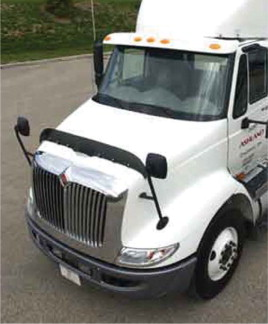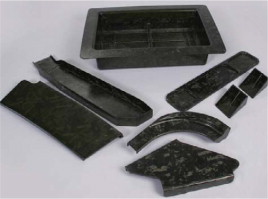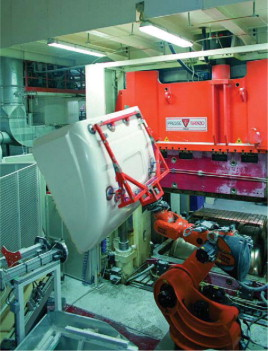




The status of materials development, processing advancements, and end-use applications for sheet moulding compounds (SMC) is a mix of good news, bad news, and old news back in the spotlight. The bad news is that car makers are in the grip of a pain-at-the-pump paradigm shift caused by escalating oil prices and demand for greater fuel efficiency and emissions control. Consequently, original equipment manufacturers (OEMs) are reducing volume production of many vehicles that utilise SMC.
The good news is that this situation has spurred demand for smaller, lighter weight vehicles that burn less gasoline, emit fewer greenhouse gases, and utilise renewable biomaterials and recyclate in components.
And there's more good news: market penetration for SMC is gaining ground in terms of both end-use applications and global demand. Suppliers are reporting more interest in SMC from industrial, consumer, building and construction, energy generation, electrical/electronic, non-automotive transportation, and even aerospace customers. New customers in China, Eastern Europe, and the Middle East are calling for SMC in multiple applications, including conventional automotive.
Formulation diversity
Perhaps the best news of all is that SMC formulations continue to abound in answer to such a diverse range of applications. Within an SMC compound's ‘recipe’ are these ingredients: the thermoset matrix resin (usually polyester but also vinyl ester and epoxy), additives such as catalysts and thickeners, pigment, mould release agents, secondary fillers such as calcium carbonate, and reinforcements (glass, carbon, natural fibres such as flax, nanoparticles, recyclate and hybrids).
Automotive applications (encompassing light vehicle and heavy truck) form the largest market for SMC, and over the past five years, automotive SMC recipes have continued to meet and enhance this segment's performance requirements. Among those are toughness, low density, low profile, conductivity, in-mould colouring and coating, and powder priming. The Automotive Composites Alliance (ACA) based in Detroit, Michigan, USA, lists 227 SMC parts on 78 different 2007 model cars and trucks manufactured globally. Whether sunshades, skid plates, valve covers, front-end structural supports and a whole range of body panels, SMC has driven its way onto the automotive production line in passenger cars, light trucks, heavy trucks, and agricultural equipment. SMC components are riding on flashy sports cars such as GM/Chevrolet's Corvette and Chrysler's Viper, to tractor-trailer trucks and robust agricultural combines, and the entire realm of minivans, crossovers and sports utility vehicles (SUVs) in between.
According to Mike Dettre, Business Manager for Closed Mold Resins, the latest news on Atryl polyester resin from AOC, Collierville, Tennessee, USA, is its use in conductive SMC as well as in carbon fibre and nanoclay reinforced formulations. The latter are used for non-appearance automotive parts such as fender liners and underhood structure. Additionally, Atryl in a 31% glass-filled, ultra-low density SMC (1.05 g/cm3) can provide tight tolerances, heat resistance, and moulded-in features for truck sunshades. The largest Class A SMC parts using Atryl are 421 cm wide by 183 cm long by 122 cm high (95 by 72 by 48 inches) hood and fender assemblies aboard Freightliner's Century Class heavy truck. This compound recipe allows for in-mould coating and compression moulding at 20% less pressure. For drivers with the need for speed, Atryl is used in SMC outer door panels, roof bow and tonneau on the General Motors Corvette.
Dettre estimates that AOC sells in excess of 27 million kg (60 million lbs) of polyester resins and additives annually for SMC in multiple markets.
Just two years ago, new recipes for powder primable SMC began solving paint popping and surface waviness problems in Class A automotive parts. Cedric Ball, Global Marketing Manager for Transportation with Ashland Composite Polymers, Dublin, Ohio, USA, tells Reinforced Plastics that “trials with Ashland's AROTRAN 610 compound in 2007 proved successful in addressing these issues. General Motors is now considering the recipe for possible use on new model vehicles.”
In Europe, automakers are currently testing Ashland's new NEULON 480 and 580 low profile additives (LPAs) in SMC components on high-end automobiles, and Ball expects trials of these LPAs in the USA within the next year.
In low-density SMC, toughened AROTRAN 720 with nanoclay fillers has reduced 21 lbs of weight from heavy truck engine hoods, such as those on International TranStar1 models. Specific density for this patented formulation in finished parts registers at 1.55 g/cm3. This April, Ashland made a major investment and put its money where its materials are, by purchasing 40 of these brawny tractor/trailer haulers for its own corporate fleet.
Another Ashland resin is offering improved weatherability in SMC. AROTRAN 805 has demonstrated reduced shrinkage, good in-mould colour retention, and UV-stability improvements that Ball suggests could be applied to SMC pickup truck boxes. He says that an economic model generated by the company indicates that a UV-stable SMC compound could reduce the cost of a compression moulded pick-up box by nearly 15% as compared to painted SMC.
“UV-stable formulations will also reduce the release of volatile organic compounds (VOCs), just as powder primable SMC has done,” Ball states, “by eliminating the need for paint and by lowering the total amount of energy needed for processing.”
Enviro-SMC
Greener, more environmentally friendly SMCs are definitely making news, and Ashland has been a pioneer in this regard. Its ENVIREZ 1807 polyester resin made with a 75/17/8% content ratio of petroleum, soybean oil and ethanol has been used since 2002 in Class A exterior styling panels on all John Deere combines, as well many of the OEM's tractor models and hay balers. A 17 236 kg (38 000 lb) batch of ENVIREZ 1807 resin removes 15 422 kg (34 000 lbs) of carbon dioxide from the air.
DSM Composite Resins, Schaffhausen, Switzerland, is reducing environmental impact through its Palapreg Premium resin system introduced this March. Florian Gosset, DSM's New Business Development Manager for Automotive, comments that this resin in SMC compound represents a breakthrough reduction in volatile organic compound (VOC) emission. Total emissions in Class A exterior SMC auto body panels made with this low-styrene polyester and now in testing by European OEMs have been measured at 100 ppm. DSM declares this a new industry standard.
For SMC recipes, Palapreg Premium resin is premixed as a single component with LPA, styrene and an inhibitor.
“The advantage for the compounder is to have only one component to dose instead of four or five,” Florian notes, “and this can result in up to 30% reduction in cycle time.”
He adds that “for composites to maintain a strong materials presence, clear recycling routes must be offered.” DSM is currently working with other suppliers and trade organisations to validate a green FRP recycling label programme.
Green news from the National Composite Center (NCC) in Kettering, Ohio, USA: the Bio-Lite Technical Center of Excellence was established there last year to examine new recipes and processing that will improve SMC compounding science. Harry Couch, Senior Technical Advisor to NCC, reports that research into nanoplatelets as a replacement for glass or carbon fibre in structural SMC recipes revealed more promise than achievable properties. So the evaluation focus has shifted to recipes that reinforce structural SMC with biomaterials such as natural fibre and recyclate.
“We are looking at biomaterials from the ground up, including natural fillers such as hemp and flax and resin components such as soybean oil,” states Dwight Rust, also an NCC Senior Technical Advisor.
Early biomaterials research at the new centre indicates the potential for lighter weight than traditional fillers in automotive components. Compared to calcium carbonate, for example, with specific gravity of 2.7 g/cm3, biobased SMC could deliver specific gravity on the order of 0.6-1.9 g/cm3. Couch believes biomaterials might also bring breakthroughs in maturation time (when the SMC compound is thickening into a semi-finished product).
“Maturation is a constant variable that we're evaluating every day in an effort to better control consistency directly from formulation to moulding,” he says.
Non-automotive applications are likely to provide the market pull for new SMC recipes, and Rust cites agricultural equipment OEMs as crucial early adopters. Both technical advisors agree that biocomposites “will have to prove to be competitive and offer practical solutions.”
The test and production scale-up capability at the Bio-Lite Center far exceeds the scope of most benchtop research. With sophisticated mechanical and thermal testing devices and electron microscopy, research staff can evaluate cure viscosity prior to actually forming sheet. This allows more in-depth examination of variables such as polymerisation and flow rate, and required compaction pressure. To test new bio-based compounds, the Bio-Lite Center has a 1000 ton press in an SMC production line capable of manufacturing up to 907 184 kg (2 million lbs).
“Within the next six months, we will know which bio-recipes have the potential to enhance SMC,” Couch states. “Then we'll capitalise upon the unique capacity at the Bio-Lite Center to produce scale-up, production-ready components and work with partners to field test these parts. These steps will allow us to facilitate moving Bio-Lite enhanced SMC components to market.”
Bringing in reinforcements
Menzolit Compounds International GmbH, Heidelberg, Germany, introduced one of the first carbon fibre SMC recipes for automotive applications back in 2004. Its AdvancedSMC formulation debuted on Daimler's Mercedes SLR Silver Arrow sports car in a three-piece scuttle panel.
Frank Bruns, CEO, recounts that moulding the AdvancedSMC, which was made from large tow carbon fibre, was possible with existing equipment after some processing adjustments. Of the three original carbon fibre SMC parts on the SLR, two have since been replaced with low-density SMC. In Bruns' opinion, the price of carbon fibre and concerns about availability continue to limit its use.
“There are many challenges to industrialising this composite besides price, including customer commitment to lighter weight materials and supplier investment in dedicated production lines so as to reduce touch labour and maturation time.”
Specific to price, Bruns states that “the key challenge is getting the price of a kilogram of carbon fibre from €15-20 (US$10-15) down to no more than four times the cost of glass fibre. We're working diligently on providing this material to OEMs. While the volumes are currently quite low, we are confident we can develop new projects with the OEMs.”
For 2008, Bruns estimates Menzolit's SMC/BMC production at about 90 000 tons, with moderate growth in Europe at 3-5%, and significant growth in China over the coming years. He also suggests that a new generation of SMC for Class A automotive parts is in the works at Menzolit that will enhance low density, very low VOC emissions, and excellent surface quality, as well as a Class A material for direct e-coating. In addition to automotive applications, the company compounds SMC for electrical and electronic, building and construction, and rail applications. Menzolit has developed a compound recipe utilising 20-40% recycled factory production scrap to manufacture swimming pool panels.
From sports cars to tour bikes to a 250-passenger aircraft, Hexcel Corp's, Stamford, Connecticut, USA, HexMC carbon fibre SMC is proof positive of the end-use diversity of SMC. With 60% discontinuous carbon fibre in an epoxy resin, HexMC can provide rapid cycle time of about five minutes (dependent upon part thickness) at 135°C (275°F). In addition to accommodating three-dimensional (3D) shapes, HexMC also features zero mould preparation and zero scrap levels.
Since SMC in aerospace parts is rare, Hexcel is making big news with its application of HexMC in the large window frames on Boeing's new 787 Dreamliner commercial aircraft. These composite frames meet strict tight tolerance targets and weigh half as much as aluminium. NORDAM Group's Interiors and Structures Division, Tulsa, Oklahoma, USA, compression moulds the frames. In May, Hexcel announced a contract with Airbus to supply carbon fibre composites in major primary structures on the new Airbus A350 XWB (extra wide body) long-range aircraft. Hexcel is offering other composite products for consideration in secondary structures and interiors, of which HexMC is one.
Another market calling upon the unique properties of HexMC is sporting goods, where the compound has been used in Benetton in-line skate frames and bicycle components such as Campagnolo's tubular crank, and the slip fit bearing on Trek's Madone bike, which was ridden to victory in last year's Tour de France. Trek Bikes, Waterloo, Wisconsin, USA, claims this bearing is integral to the Madone's innovative bottom bracket-in-frame design, which increases stiffness, cuts component weight by 50 g and helps dial in superior ride quality.
Hexcel designed HexMC for creating parts from composites that could not be economically made from metals or prepreg because of geometric complexity and weight constraints. In performance, price and processability, the supplier states that “this SMC falls somewhere between standard SMC and a quasi-isotropic laminate.” The carbon fibre filled SMC can also be blended with Hexcel's HexPly prepreg, without necessarily requiring autoclave cure. A specific range of HexPly prepregs are available for co-moulding HexMC SMC parts to gain the benefit of continuous and non-continuous reinforcement properties.
The sporting life
After a year and half in development, DION 31616-00/31100-00, a hybrid polyester/polyurethane resin from Reichhold Inc, Research Triangle Park, North Carolina, USA, has demonstrated compatibility with both nanoparticulate and carbon fibre reinforcement in SMC compounds. John Ilkka, Closed Mold Business Development Manager, says this formulation brings the flexibility and toughness of polyurethane together with the high strength, stiffness and temperature resistance of unsaturated polyester. The hybrid resin also features higher overall impact properties as compared to traditional SMC resins. Automakers have shown an interest, but Ilkka believes non-automotive applications will make the first breakthroughs.
One of those breakthrough applications might be in personal watercraft, such as the Waverunners from Yamaha Watercraft Group, Kenneshaw, Georgia, USA. The hulls, decks and liners on the 2008 SHO and HO Waverunner models use NanoXcel, the OEM's own recipe for nanoclay reinforced SMC. According to Yamaha, this use of SMC is an industry first.
Interplastic Corp, St. Paul, Minnesota, USA, compounds the low-density NanoXcel SMC for Yamaha with a hybrid resin, achieving a 25% weight reduction over standard SMC. Yamaha has invested in its own compression moulding capability.
Compounding the advantages
With base resin and compound prices rising, along with costs for the energy to conduct processing, some moulders are extending their technology grasp by adding in-house compounding. Such is the case for the Automotive Composites Division of the Polytec Group, Hoersching, Austria. Having purchased Menzolit-Fibron's moulding business last year, Polytec claims to be the largest supplier of composite moulded parts in Europe, with core competencies in complex automotive roof systems, body panels, and structural components.
Karl-Heinz Solly, Chief Marketing Officer, relays that this division produces and processes more than 25 000 tons of SMC a year. He also believes the importance of the Menzolit-Fibron moulding business acquisition will likely increase the Polytec Group's total revenues this year by 35%; the company's 2008 annual sales target is €800 million. Solly says the division's in-house compounding expertise “allows us to control the complete value chain from materials development through compression moulding, all post-moulding operations, and on to body colour painting and final assembly of components to systems and modules.”
Currently Polytec is moulding automotive and truck components for some 15 global OEMs in Europe, Brazil, Turkey, Mexico and the USA. Though only 4% of the division's business is in non-automotive products, including electronic switches, parabolic mirrors and bases for dental chairs, Solly points out that “these customers play a vital role within our overall composites activities.”
Stateside in Allen Park, Michigan, Meridian Automotive Systems Inc, upgraded its SMC compounding capabilities last year at its Grabill, Indiana, facility to match its capabilities as one of the largest moulders of composites in North America. Reinforced Plastics asked Dan Dowdall, Vice President of Engineering and Product Development, and David Ulrich, Director of Sales for Consumer and Industrial Products, to assess the synergism of the moulding and in-house compounding operations so far.
Ulrich believes “we've far exceeded expectations in compatibility and have been able to offer our customers significant cost reduction on most projects.”
Dowdall agrees: “This has been absolutely a plus from a quality standpoint, since a good SMC part starts with a good compound.”
Through the expansion, Meridian is developing and producing customised SMCs to meet new customer needs. Examples include a carbon fibre reinforced SMC for the 2008 Dodge Viper's doors and fender supports, and SMC recipes for a variety of industrial and consumer products including blower housings, drain pans, and heating, ventilation and air conditioning (HVAC) systems.
“HVAC products bring a whole new set of requirements,” Dowdall observes, “including safety properties such as flame, smoke and toxicity (FST), high structural strength, and Underwriters Laboratory (UL) approval.”
Ulrich reports that Meridian has an SMC compound that is now UL approved. The material has been used in a 0.89 m by 2.03 m (35 inches wide by 80 inches long) base for an HVAC system that Meridian moulds from its own SMC. The moulder/compounder helped the system OEM reduce dozens of parts down to one 3.5 mm-thick part that can support 363 kg (800 lbs). Ulrich says the company is now evaluating an SMC compound for HVAC applications that includes antimicrobial additives to address standing water issues.
Automotive remains Meridian's primary market; one successful, high volume application of the company's moulding and compounding talents comes in the unique SMC/flax trunk divider for Nissan's popular Sentra sedan. Meridian also compounds and moulds parts for the Chevrolet Corvette with its SLI-323 SMC, and moulds structural components on the Dodge Viper. Still, Dowdall agrees that traditional applications in this market are in flux, with global economic factors perhaps finally opening the door to wider adoption of composites among standard vehicle production materials.
‘Standard vehicles’ are getting lighter to accommodate hybrid, electric, and fuel cell propulsion systems. Meridian led a benchmarking study of a prototype hybrid sedan to determine weight savings and other benefits composites could contribute as improvements over metals. The study indicates that SMC could provide a 25-35% weight savings in deck lids through part consolidation, as well as lending itself to antennae embedment.
Ashland's Ball believes “the real end game for structural SMC is alternate fuel vehicles,” and NCC's Couch states that “there is the potential for SMC to save weight in cars by 12 times as much as the formulations that were available in the 1980s.” AOC's Dettre has “little doubt that lighter weight vehicles and alternate power sources are in our future, and I fully expect composites in some form or fashion to play an important role in this transformation.”
Both Polytec and Meridian use Dieffenbacher compression presses. This Eppingen, Germany-based equipment OEM is extending in-house SMC formulation control for moulders to an even greater degree with its in-line compounding technology. Dieffenbacher has already developed in-line compounding equipment for compression and injection moulding of long glass fibre reinforced thermoplastics.
For its in-line SMC system, the OEM has developed direct strand moulding compound (D-SMC). Thomas Müllner, head of the Composites Sales Division in Dieffenbacher's forming business, reports that D-SMC can cut significant cost from processing time by reducing maturation time from hours to minutes. Further, the company's microwave-assisted, continuous, and closed-loop configuration for in-line SMC compounding will reduce styrene emissions, make near real-time recipe changes possible, and utilise the parallel motion controllers on Dieffenbacher presses to keep parts centered under moulding pressure.
According to Müllner, the key variable in the new process is optimising platen deflection and the bending line between the ram and press table. D-SMC was developed with industry and academic partners and funded by the German government. Watch for upcoming news: Müllner says proof of the in-line SMC compounding technology is likely to occur before the end of this year.
Old news anew
While there's nothing new about SMC's proven performance in diverse applications, surprisingly the material is not perceived as on par with steel. Good news, however, are the many benefits of SMC:
- reduced mass;
- design freedom through part reduction and function integration;
- in-mould colouring and powder priming;
- corrosion resistance;
- lower tooling costs; and
- increasing opportunities to replace metals.
SMC compounder IDI Composites, of Noblesville, Indiana, USA, produced 6.8 million kg (15 million lbs) of SMC in 2007, and this year has commercialised three compounds suited for metal replacement. AV-206 features high heat and creep resistance plus light weight and good NVH (noise, vibration, harshness) properties — all a positive fit for heavy truck applications. IDI's E-200 SMC provides high strength, chemical and corrosion resistance, and structural rigidity for components such as lids, weir plates, control valves, and covers for water tanks and manholes. The compounder's X Series SMC composite is durable, light weight and impact resistant in safety helmets, as well as automotive and aerospace products.
Paul Rhodes, IDI's Vice President of Marketing, reports the compounder is working successfully in replacing metal with SMC for automotive Class A and engine components, as well as heavy truck and off-road equipment parts. Advancements have also been made in IDI's SMC recipes for moulded-in colour uniformity, and to provide antimicrobial, low FST, and ballistic properties.
So what's the overall scoop on SMC technology today?
AOC's Dettre remarks that “the fact that less SMC is currently being used in the automotive industry shouldn't be a negative reflection on the material performance. As an industry, SMC suppliers and moulders have stepped up to the plate and met virtually each and every technical challenge that OEMs have required.”
Indeed SMC technology gains are being delivered, and the industry continues to educate customers on both the well known and new advantages of this composites form. Hopefully the next breaking news will report dramatic demand for SMC resulting from the changing trends reported here.




